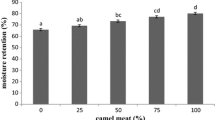Abstract
Experiments were conducted to determine the effect of blooming, retail display and vitamin C on colour changes/improvement of buffalo meat. To evaluate the effect of blooming, top round cuts of buffalo were allowed to bloom for 60 min. As colour bloomed, a* value increased from 6.47 to 10.01 at 45 min; no further changes occurred. In another study, top round cuts were kept at ambient temperature (36 ± 2 °C) and evaluated for instrumental colour during display. The instrumental redness value (a*) and chroma significantly increased (P < 0.05) after 12 h of display. During storage at refrigerated temperature, treatments consisted of injecting muscle section with 5 % by weight of 0.5, 1 and 2 % vitamin C solutions and a non-injected control (0 %). Each part was evaluated for instrumental colour changes and sensory traits (colour and discoloration score) at 0, 3, 6 and 9th day of refrigerated storage. The a* value (redness) increased significantly in all vitamin C treated buffalo meat samples as compared to control stored at 4 °C. The chroma was significantly higher (P < 0.05) in treated meat as compared to control. Buffalo meat containing vitamin C maintained the desired red meat colour throughout the storage period. The buffalo muscle treated with 2 % vitamin C was more effective in preventing discoloration than treated with 0.5 and 1 % vitamin C. In our study it is evident that as colour bloomed, a* value (redness) increased which indicated that buffalo muscles became redder immediately after exposure to air during blooming and retail display. Vitamin C at levels between 0.5 and 2 % will minimize the rapid discoloration that occurs at the muscle surface. However, 2 % concentration of vitamin C was more effective in minimizing the discoloration and improving colour stability.
Similar content being viewed by others
References
AMSA (1991) Guidelines for meat colour evaluation. American Meat Science Association and National Livestock and Meat Board. Proc Recip Meat Conf 44:233–249
Anderson BA, Lauderdale JL, Hoke JM (1985) Composition of food: beef products. Agric handbook No. 8–13. U.S. Department of Agriculture, Washington, DC
Brewer MS, Zhu LG, Binder B, Meisinger DJ, McKeith FK (2001) Measuring pork colour: effects of bloom time, muscle, pH and relationship to instrumental parameters. Meat Sci 57:169–176
CIE (1978) International commission on illumination, recommendation on uniform colour spaces, colour difference equation, psychometric colour terms. Supplement No.2. Bureau Central de la, CIE, Paris
FAO (2009) FAO production year book. 62, Rome, Italy
Friedrich L, Siro L, Dalmadi I, Horvath K, Agoston R, Bulla CS (2008) Influence of various preservatives on the quality of minced beef under modified atmosphere at chilled storage. Meat Sci 79:332–343
Kerth CR, Miller MF, Ramsey CB (1995) Improvement of beef tenderness and quality traits with calcium chloride injection in beef loins 48 hours postmortem. J Anim Sci 73:750–756
Ledward DA (1992) Colour of raw and cooked meat. In: Johnson DE, Knoght MK, Ledward DA (eds) The chemistry of muscle based foods. Royal Society of Chemistry, London, pp 128–144
Lee MS, Apple JK, Yancey JWS, Sawyer JT, Johnson ZB (2008) Influencing of wet ageing on bloom development in longissimus thoracis. Meat Sci 80:703–707
Naveena BM, Muthukumar M, Sen AR, Babji Y, Murthy TRK (2006) Improvement of buffalo meat using lactic acid, clove oil and vitamin C during retail display. Meat Sci 74:409–415
Naveena BM, Sen AR, Muthukumar M, Babji Y, Kondaiah N (2011) Effects of salt and ammonium hydroxide on the quality of ground buffalo meat. Meat Sci 87:315–320
Realini CE, Duckett SK, Windham WR (2004) Effect of vitamin C addition to ground beef from grass-fed or grain-fed sources on colour and lipid stability, and prediction of fatty acid composition by near-infrared reflectance analysis. Meat Sci 68:35–43
Renerre M (1990) Review: factors involved in the discolouration of beef meat. Int J Food Sci Technol 25:613–630
Sahoo J, Anjaneyulu ASR (1997) Quality improvement of ground buffalo meat by preblending with sodium ascorbate. Meat Sci 46:237–247
Shivas SD, Kropf DH, Hunt MC, Kastner CL, Kendall JLA, Dayton AD (1984) Effects of ascorbic acid on display life of ground beef. J Food Prot 47:11–15
Skrlep M, Candek-Potokar M (2007) Pork colour measurement as affected by bloom time and measurement location. J Muscle Foods 18:78–87
SPSS 12.0 (2003) SPSS manual. SPSS Inc, Chicago
Yin MC, Faustman C, Riesen JW, Williams SN (2006) Tocopherol and ascorbate delay oxymyoglobin and phospholipid oxidation in vitro. J Food Sci 58:1273–1276
Zhu LG, Brewer MS (1998) Discolouration of freshly cut normal, PSE and DFD pork during retail display. J Food Sci 63:763–767
Zhu LG, Binder B, Brewer MS (2001) Postmortem pH, muscle and refrigerated storage effects on ability of vacuum packaged pork to bloom. J Food Sci 66:1230–1235
Acknowledgments
Authors are thankful to the Officer on Special Duty, NRC on Meat, Hyderabad for providing necessary facilities.
Author information
Authors and Affiliations
Corresponding author
Rights and permissions
About this article
Cite this article
Sen, A.R., Muthukumar, M., Naveena, B.M. et al. Effects on colour characteristics of buffalo meat during blooming, retail display and using vitamin C during refrigerated storage. J Food Sci Technol 51, 3515–3519 (2014). https://doi.org/10.1007/s13197-012-0882-x
Revised:
Accepted:
Published:
Issue Date:
DOI: https://doi.org/10.1007/s13197-012-0882-x




